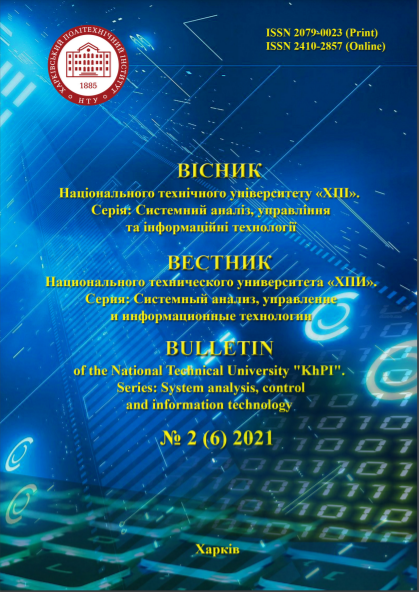SOFTWARE TESTING RESULTS ANALYSIS FOR THE REQUIREMENTS CONFORMITY USING NEURAL NETWORKS
DOI:
https://doi.org/10.20998/2079-0023.2021.02.02Keywords:
quality, requirement, testing, pipe-line, machine learning, CI/CD, Google, ANFISAbstract
The relevance of scientific work lies in the need to improve existing software designed to analyze the compliance of the results of software testing of
the stated requirements. For the implementation of this goal, neural networks can be used by quality control specialists to make decisions about
software quality, or project managers as an expert system, for one of the quality indicators for the customer. The article deals with software testing
which is a process of validation and verification of compliance of the software application or business program with the technical requirements that
guided its design and development, and work as expected, and identifies important errors or deficiencies classified by the severity of the program to be
fixed. Existing systems do not provide for or have only partial integration of systems of work with the analysis of requirements, which should ensure
the formation of expert assessment and provide an opportunity to justify the quality of the software product. Thus, a data processing model based on a
fuzzy neural network was proposed. An approach to allow determining the compliance of the developed software with functional and non-functional
requirements was proposed, taking into account how successfully or unsuccessfully implemented this or that requirement. The ultimate goal of
scientific work is the development of algorithmic software analysis of compliance of software testing results to stated requirements for support in the
decisions taken. The following tasks are solved in scientific work: analysis of advantages and disadvantages of using existing systems when working
with requirements; definition of general structure and classification of testing and requirements; characteristic main features of the use of neural
networks; designing architecture, the module of research of conformity of results of testing software to the stated requirements.
References
Bentley J.., Bank W., Charlotte N. C. Software Testing Fundamentals – Concepts, Roles, and Terminology‖. Planning, Development and Support. Available at https://support.sas.com/resources/papers/proceedings/proceedings/s ugi30/141-30.pdf (access date: 29.09.2021).
Farooq Sh. U., Quadri S. M. K. Effectiveness of Software Testing Techniques on a Measurement Scale‖. Oriental Journal of Computer Science & Technology. 2010. № 3(1). pp. 109-113.
Jenkins N. A Software Testing Primer v.2. OPENLIBRA, 2017. 55 p.
Myers G. J. The art of software testing 3rd edition. New York: Wiley, 2011. 256 p.
BABOK V3 a guide to the business analysis body of knowledge Available at https://book.akij.net/eBooks/2018/September/5b8a80dd494ce/BAB OK_Guide_v3_Member.pdf (access date: 29.10.2021).
Kruglov V.V., Dli M.I., Golunov R.Yu. Fuzzy logic and artificial neural networks. Moscow: Fizmatlit, 2001. 224 p.
Kruse R. Fuzzy neural network. Available at http://www.scholarpedia.org/article/Fuzzy_neural_network (access date: 11.09.2021).
Jang JSR. ANFIS: Adaptive-network-based fuzzy inference system. IEEE Trans Syst, Man, Cybernet. 1993. no 23(3). pp. 665–685.
Beg, Ismat & Ashraf, Saminax. Similarity measures for fuzzy sets. Applied and Computational Mathematics. 8. 2009 192-202.
DevGoogle. Data Preparation and Feature Engineering for Machine Learning. Available at https://developers.google.com/machine-learning/dataprep/transform/normalization#z-score (access date: 11.09.2021).
Chakraverty S., Sahoo D.M., Mahato N.R. Defuzzification. In: Concepts of Soft Computing. Springer, 2019 Singapore. Available at https://doi.org/10.1007/978-981-13-7430-2_7 (access date: 10.10.2021).
Fowler, M, Foemmel M. Continuous integration. (2006). Available at https://moodle2019- 20.ua.es/moodle/pluginfile.php/2228/mod_resource/content/2/martin -fowler-continuous-integration.pdf (access date: 10.10.2021).
Downloads
Published
How to Cite
Issue
Section
License
LicenseAuthors who publish with this journal agree to the following terms:
- Authors retain copyright and grant the journal right of first publication with the work simultaneously licensed under a Creative Commons Attribution License that allows others to share the work with an acknowledgement of the work's authorship and initial publication in this journal.
- Authors are able to enter into separate, additional contractual arrangements for the non-exclusive distribution of the journal's published version of the work (e.g., post it to an institutional repository or publish it in a book), with an acknowledgement of its initial publication in this journal.
- Authors are permitted and encouraged to post their work online (e.g., in institutional repositories or on their website) prior to and during the submission process, as it can lead to productive exchanges, as well as earlier and greater citation of published work (See The Effect of Open Access).


